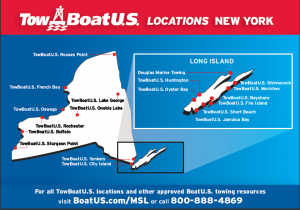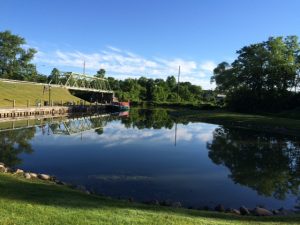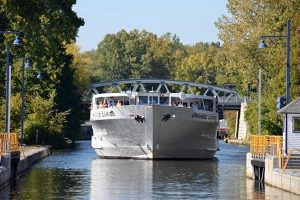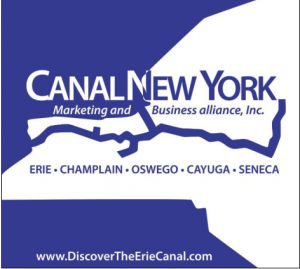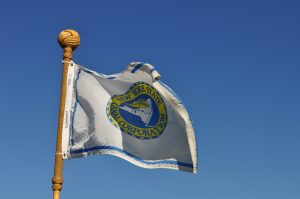Boating on the Erie Canal
Post courtesy of the www.newyorkboater.com
Whether you’re in a kayak, 50’ cruiser or anything in-between you will find a unique boating experience on the Erie Canal. With 55 locks, 16 lift bridges, more than 60 communities all on the 524 miles of navigable waterway that make up the Erie Canal System. A boat trip on the Erie is something you won’t soon forget. Whether you plan your trip to last a day, week or month the Erie will not disappoint.
The NYS Canal system is best understood when you break it down by regions. The Erie at 363 miles long stretches from Waterford, just north of Albany to The Tonawanda’s, just east of Buffalo. The modern version of the Erie which celebrated its centennial in 1915 combines the natural river sections of the Mohawk and Seneca Rivers, crosses Oneida Lake, the largest lake completely within NYS as well as the man-made sections that complete the system. The scenery that you encounter along the way is as diverse as the waterway itself. From dairy farms and apple orchids to long stretches of natural scenery that could make you forget you’re in New York State. You will also pass through bedroom communities of cities like Syracuse and Rochester. One of the more interesting sections is a 4-mile-long stretch west of Rochester where the Canal is cut through rock, with rock walls on both sides of the canal, take a minute to consider how this section was built virtually by hand in the early 1800’s! When you arrive in Tonawanda, the current western terminus of the Canal, rent a car and visit Niagara Falls, or continue on the Niagara River 13 miles to the inner harbor of Buffalo where you have the opportunity to dock directly behind a Naval Destroyer at the only inland Naval Museum in the country.
From the Erie Canal, you also have the opportunity to head north to Lake Ontario via the Oswego Canal, At Three Rivers, mile marker 160 the Oswego Canal heads north for 23 miles. Don’t miss a stay in the village of Phoenix where undoubtable you will get a visit from the Bridge House Brats, a local youth group who spends their summers helping boaters with everything from catching your lines to running for provisions. Oswego at the mouth of Lake Ontario hosts one of the largest celebrations of the summer with its annual Harbor Fest.
Travel a little further west and at mile marker 200 on the Erie you can head south on the Cayuga / Seneca Canal. When you exit Lock 1, 4 miles south of the junction with the Erie, Cayuga Lake lies ahead, 36 miles to the south is the City of Ithaca, or head west to the historic town of Seneca Falls, birthplace of the women’s suffrage movement. Seneca Falls is one of the best stops along the Canal for boaters, with over 900’ of dockage on both the north and south sides of the Canal, boaters can enjoy free docking, electric, water, wi-fi and a boaters amenity center that offers laundry, showers, a lounge. An easy walk offers boaters access to restaurants, shops, and museums. Rent a car and tour the many wineries that surround the Finger lakes. The Cayuga / Seneca Canal continues west past the village of Waterloo, the birthplace of the memorial day celebration and eventually empties into the north end of Seneca Lake at the city of Geneva. Head south 34 miles for a visit to Watkins Glen.
The Champlain Canal which travels north from the Village of Waterford and the Hudson River follows some of the same waterways that were critical in the Revolutionary war, with historical sites located throughout the 60-mile length. The Champlain offers the scenery of the Adirondack mountains to the west and the Green Mountains of Vermont to the East. Continue to Lake Champlain and north to Canada and beyond.
No matter how you choose to boat on the Erie Canal system, you won’t be disappointed. More than 60 communities offer docking opportunities to transient boaters, most offering amenities such as electric, internet access, showers and restrooms and access to these communities. Most them are FREE.
There are three ways to boat the canal, you can use your own boat and of course depending on where your home port is will determine where you enter the canal system from. If you trailer your boat, you have a lot more options. With over 150 boat ramps and more than 100 marinas and public docks on the Canal System there are lots of options for your trip. If your boat has sleeping accommodations, your options have greatly increased, if not, or if you’re paddling the canal, you can stay at any of the B&B’s or hotels or campgrounds along the Canal. If roughing it is your desire you can dry camp for free at every one of the 57 locks along the Canal system.
The third way to enjoy the Canal System by water is to charter a boat. There are several companies along the Canal System that will rent you a boat for as little as 3 days. These options vary from a 22’ cruiser perfect for a couple to several companies which rent European Style Canal boats in sizes from 32-42 such as the one below from Mid lakes Navigation ’ or how about doing a family reunion on a 60’ house boat which accommodates 14. No matter which option works for you, a trip on the Canal is a must for any NY Boater. In 2015 Lyons NY, at mile marker 220 of the Erie hosted 331 boats from 216 communities in 40 states and from Canada, Holland, Australia, England, Germany, Sweden, New Zealand, Ireland, Mexico, and South America. Start experiencing what boaters from around the country and world are finding out. In 2017 the Canal System begins the celebration of the bi-centennial of the beginning of the construction of the Canal. Also in 2017 The World Canals Conference is coming to Syracuse from Sept. 25th to the 29th.
’ or how about doing a family reunion on a 60’ house boat which accommodates 14. No matter which option works for you, a trip on the Canal is a must for any NY Boater. In 2015 Lyons NY, at mile marker 220 of the Erie hosted 331 boats from 216 communities in 40 states and from Canada, Holland, Australia, England, Germany, Sweden, New Zealand, Ireland, Mexico, and South America. Start experiencing what boaters from around the country and world are finding out. In 2017 the Canal System begins the celebration of the bi-centennial of the beginning of the construction of the Canal. Also in 2017 The World Canals Conference is coming to Syracuse from Sept. 25th to the 29th.
The NYS Canal system is the oldest continually operating transportation system in North America, and every year the navigation system begins in Early May and closes during the middle of November. A common message you will hear from boaters enjoying the Canal, is quiet!, don’t spread the word. those who already are in the know really want to keep it a closely guarded secret.
A boat trip on the Erie Canal, may be the best deal in cruising around! Continue to watch the New York Boater for more information as the NYS Canal system begins their bi-centennial celebration starting in 2017
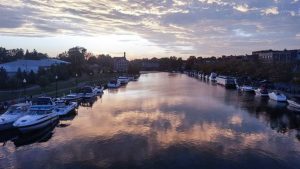












 ’ or how about doing a family reunion on a 60’ house boat which accommodates 14. No matter which option works for you, a trip on the Canal is a must for any NY Boater. In 2015 Lyons NY, at mile marker 220 of the Erie hosted 331 boats from 216 communities in 40 states and from Canada, Holland, Australia, England, Germany, Sweden, New Zealand, Ireland, Mexico, and South America. Start experiencing what boaters from around the country and world are finding out. In 2017 the Canal System begins the celebration of the bi-centennial of the beginning of the construction of the Canal. Also in 2017 The World Canals Conference is coming to Syracuse from Sept. 25th to the 29th.
’ or how about doing a family reunion on a 60’ house boat which accommodates 14. No matter which option works for you, a trip on the Canal is a must for any NY Boater. In 2015 Lyons NY, at mile marker 220 of the Erie hosted 331 boats from 216 communities in 40 states and from Canada, Holland, Australia, England, Germany, Sweden, New Zealand, Ireland, Mexico, and South America. Start experiencing what boaters from around the country and world are finding out. In 2017 the Canal System begins the celebration of the bi-centennial of the beginning of the construction of the Canal. Also in 2017 The World Canals Conference is coming to Syracuse from Sept. 25th to the 29th. 